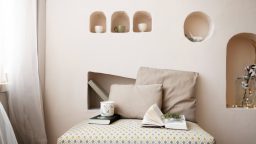Learning how to make a small bedroom look bigger is all about using smart visual tricks, thoughtful furniture choices and strategic styling to open up the space without changing the room’s actual size. Small bedrooms can feel calm, airy and comfortable when each detail is chosen with intention. With the right approach, even the most compact layout can gain a sense of openness and balance.
Start with a light and cohesive colour palette. Soft neutrals — warm white, pale beige, muted grey or gentle pastel tones — reflect more light and reduce visual heaviness. When the walls, bedding and furniture stay within a similar palette, the room feels more seamless and spacious. You can still add depth with texture, but keep large colour contrasts to a minimum to avoid breaking up the visual flow.
Furniture proportion is crucial. Choose pieces that suit the room rather than oversized designs. A streamlined bed frame with slim legs, for example, allows more floor to remain visible and instantly opens the space. Floating nightstands, wall-mounted shelves and narrow dressers maintain functionality while reducing bulk. If your bedroom allows, placing the bed against the longest wall creates a balanced layout that feels less cramped.
Multi-functional furniture offers extra value in small rooms. Beds with drawers, lift-up storage or slim under-bed boxes keep belongings out of sight and maintain a tidy look. Clutter is one of the quickest ways to make a small bedroom feel even smaller, so built-in storage and hidden compartments help preserve openness without sacrificing practicality.
When understanding how to make a small bedroom look bigger, mirrors act as one of the most effective tools. A large wall mirror or a tall floor mirror reflects natural light and makes the room appear deeper. Position mirrors opposite windows or light sources to maximise the brightness. Mirrored furniture pieces or glossy surfaces can also enhance this effect, though they should be used sparingly.
Lighting shapes the atmosphere and visual scale. Instead of relying solely on overhead lighting, layer your lights with wall sconces, bedside lamps or soft LED strips. These smaller, warmer light sources create dimension and prevent harsh shadows that shrink the room. Wall-mounted lighting saves surface space and keeps the bedside area streamlined.
Selecting the right textiles also helps expand the room visually. Light curtains in sheer or linen-like fabrics allow natural light to filter through, while hanging them high and wide elongates the wall and makes the window appear larger. Bedding in calming, monochromatic tones maintains a sense of unity, and a low-pile rug placed under the bed subtly anchors the layout without overwhelming the floor space.
Keep decorative elements minimal but intentional. A few carefully chosen pieces — such as a ceramic vase, a framed print or a small plant — bring warmth without contributing to clutter. Avoid overloading shelves or surfaces. Instead, prioritise clean lines and empty space to maintain a sense of breathing room.
Consider vertical space for both storage and design. Tall wardrobes, high shelving and artwork hung slightly higher create upward movement that visually extends the walls. Vertical lines in curtains, wall patterns or furniture legs add height and prevent the room from feeling boxy.
Hidden cable management and organised surfaces make a noticeable difference. Exposed cords, overflowing nightstands or scattered accessories disrupt the room’s visual calm. Use trays, baskets and drawer organisers to maintain order. A tidy room always feels more spacious, regardless of its size.
If your bedroom includes dark furniture, balance it with lighter accessories and plenty of natural light. You don’t need to replace everything — simply pairing richer wood tones with soft textiles, light rugs and neutral bedding can reintroduce openness without starting from scratch.
Ultimately, discovering how to make a small bedroom look bigger comes down to cohesion, light and simplicity. By choosing the right colours, scaling the furniture correctly and eliminating unnecessary visual weight, you can transform a compact bedroom into a peaceful, airy retreat.
A well-planned small bedroom becomes a functional, beautiful space that supports relaxation and daily comfort. Keep experimenting with colour, lighting and layout until the room feels open and harmonious, and consult a design specialist if you need guidance tailoring these ideas to your specific layout.





